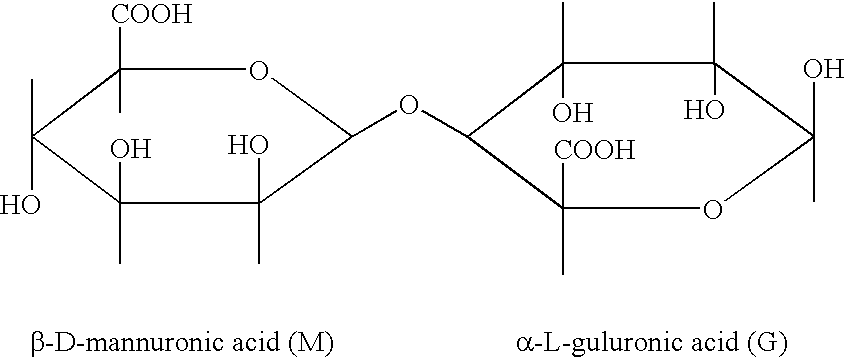Ophthalmic Alginate Composition Related Methods of Manufacture and Methods of Use
a technology of alginate and composition, which is applied in the field of ophthalmic compositions comprising alginate, can solve the problems of negative impact on the efficacy of antimicrobial agents, and achieve the effects of reducing interaction, improving coating properties, and relieving symptoms of dry ey
- Summary
- Abstract
- Description
- Claims
- Application Information
AI Technical Summary
Benefits of technology
Problems solved by technology
Method used
Image
Examples
example 1
Formulation
[0038]The following ingredients and respective amounts are used to make a base formulation with different alginate sources having different amounts of guluronic acid residues bound to adjacent guluronic acid residues: Lessonia nigrescens (ALG-LN) and Laminaria digitata (ALG-LD).
TABLE 1Base Alginate FormulationIngredientsmg / g% w / wBoric Acid50.5Sodium Borate0.140.014Glycerin60.6Propylene Glycol60.6Alginate2.50.25HAP (30%)0.50.05Alexidine 2HCl3 ppm3 ppmPurified Waterq.s. to 1000 mgq.s. to 100%w / w
TABLE 2Types of Alginate and CharacterizationFormulationSeaweedM / G% M% G% MM% GGALG-LDLaminaria1.2255453929ALG-LNLessonia1.5060404323
[0039]Formulation Process: A volume of purified water that is from about 85% to about 90% of the total batch weight (the temperature of purified water should be below 40° C. before adding any raw material) is added into an appropriate stainless steel mixing vessel. Preferably, the temperature of the purified water should be below 40° C. during this step...
example 2
HPLC Analysis of Alexidine in Alginate Formulation
[0042]Solutions from alginate source (ALG-LD and ALG-LN) were prepared according to the base formulation except that zinc chloride was added in four solutions. The solutions were analyzed as follows.
[0043]A quantitative HPLC method for the determination of Alexidine dihydrochloride in the test solutions was performed. The method involved the separation of Alexidine from other formulation components using a YMC Basic reverse-phase HPLC column and a two-pump gradient system. The mobile phase gradient begins with 65% mobile phase A (acetate buffer, pH 5.1): 35% mobile phase B (acetonitrile) and ramps to 30% A: 70% B. Adjustments to the gradient composition may be made in order to optimize the chromatography.
[0044]Detection of the separated Alexidine peak is performed using UV detection at 235 nm. Quantitation of Alexidine in samples is performed versus a multi-point Alexidine standard curve generated using standards of known Alexidine d...
PUM
| Property | Measurement | Unit |
|---|---|---|
| Fraction | aaaaa | aaaaa |
| Fraction | aaaaa | aaaaa |
| Fraction | aaaaa | aaaaa |
Abstract
Description
Claims
Application Information
 Login to View More
Login to View More - R&D
- Intellectual Property
- Life Sciences
- Materials
- Tech Scout
- Unparalleled Data Quality
- Higher Quality Content
- 60% Fewer Hallucinations
Browse by: Latest US Patents, China's latest patents, Technical Efficacy Thesaurus, Application Domain, Technology Topic, Popular Technical Reports.
© 2025 PatSnap. All rights reserved.Legal|Privacy policy|Modern Slavery Act Transparency Statement|Sitemap|About US| Contact US: help@patsnap.com

